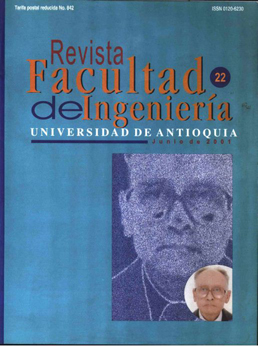Síntesis y caracterización de las zeolitas ZSM-5 y BETA con galio
DOI:
https://doi.org/10.17533/udea.redin.325959Palabras clave:
Ga, BETA, ZSM-5, óxidos de nitrógeno, reducción catalítica selectiva.Resumen
Se sintetizaron varias zeolitas con galio. Este último se introdujo por impregnación húmeda incipiente (Ga/ZSM-5 y Ga/BETA) y por incorporación desde el gel de síntesis (Ga-ZSM-5 y Ga-BETA). Los materiales resultantes se caracterizaron por XRD, XPS y 27 Al, 29Si, 71Ga MAS-NMR. Las zeolitas impregnadas experimentaron desaluminación después de la calcinación a 500 ºC durante 4 h. La adición de galio en el gel de síntesis permitió incorporarlo en la estructura de la zeolita ZSM-5 pero no en la BETA. Al comparar el comportamiento de las zeolitas ZSM-5 y BETA con galio en la reducción catalítica selectiva (RCS) de Nüx con metano, se encontró que la zeolita Ga/BETA es más activa y selectiva que Ga-ZSM-5.Descargas
Citas
Parvulcscu. V. l. et al. "Catalytic removal ofNo··. En: Catalysis Today. Vol. 46, Amsterdam, 1998, p. 233. DOI: https://doi.org/10.1016/S0920-5861(98)00399-X
Traa, Y. et al. "Zeolite-based materia Is for the selective catalytic reduction of NOx with hydrocarbons". En: Microporous and Mesoporous Materials. Vol. 30, Amsterdam, 1999, p. 3. DOI: https://doi.org/10.1016/S1387-1811(99)00030-X
Petunchi, J. O. et al. ''Srudies ofthe selective reduction ofnitric oxide by hydrocarbons"'. En: Applied Catalysis
B. Vol. 2, Amsterdam, 1993. p. 303.
Li. Y. and Armor, J. N. ··catalytic reduction of nitrogen oxides with methane in the presence of excess oxygen" En: Applied Cata(rsis B. Vol. 1. Amsterdam, 1992, p. L3 l. DOI: https://doi.org/10.1016/0926-3373(92)80050-A
Ohtsuka, H. et al. "A study on the roles of cobalt specics in Ox reduction by propane on Co-Beta". En: Catalysis Today. Vol. 42. Amsterdam. 1998. p. 45. DOI: https://doi.org/10.1016/S0920-5861(98)00075-3
Li, Y. and Armor, J. N. "Selective catalytic reduction of NOx with methane over metal exchanged zeolites•·. En: Applied Catalysis B. Vol. 2. Amsterdam. 1993. p. 239. DOI: https://doi.org/10.1016/0926-3373(93)80051-E
Li, Y. and Annor. J. N. "Selective catalytic reduction of O with methane on gallium catalysts". En: Joumal ofCaralysis. Vol. 145. New York, 1994, p. l. DOI: https://doi.org/10.1006/jcat.1994.1001
Chao, K. J. et al. "Characterization of incorporated gallium in beta zeofüe'·. En: Zeolites. No. 18. New York. 1997, p. 18. DOI: https://doi.org/10.1016/S0144-2449(96)00107-8
Thomas, J. M. and Thomas. W. J. Principies and Practice of Hererogeneous Cata(vsis. Weinheim. VCH. 1997. pp. 166-178.
Wagner, C. D. et al. Hcmdbook of X-ray PhotoelectronicSpectroscopy. New York. Perkin-Elmer Corporation. 1978. pp. 86-184.
Occclli. M. L. et al. "Crystalline galliosilicate molecular sieves with the beta structure". En: Microporous and Mesoporo11s Materials. Vol. 30, Amsterdam, 1999. p. 219. DOI: https://doi.org/10.1016/S1387-1811(99)00011-6
Vaudry, F. et al. "Aluminum-rich zeolite beta''. En:Zeolites. o. 19, New York, 1997, p. 253. DOI: https://doi.org/10.1016/S0144-2449(97)00083-3
Jarman, R. H. et al. lntrazeolite Chemistry: A-Type Zeolites. New York. American Chemical Society. 1983. pp. 267-281. DOI: https://doi.org/10.1021/bk-1983-0218.ch016
Cho, H. H. et al. ··Synthesis and Characterization of Gallosilicate Molecular Sieves with High Gallium Contents: Examples of Structure Direction Exerted by Gallium". En: Chemist1y of Marerials. Vol. 12, No. 8, New York, 2000, p. 2.292. DOI: https://doi.org/10.1021/cm0001051
Kim, S. H. et al. ··Synthesis and characterization of Ga-substituted MER-type zeolites". En: Microporous and Mesoporous Marerials. Vol. 42, Amsterdam, 2001, DOI: https://doi.org/10.1016/S1387-1811(00)00315-2
p. 121.
Ta bata, T. et al. ·· Adsorption properties of oxygen and methane on Ga-ZSM5: the origin ofthe selectivity of NOx reduction using methane". En: Catalysis Letrers. Vol. 25, 1994, p. 393. DOI: https://doi.org/10.1007/BF00816319
Vetribel, R. et al. Science and Technolog in catalysis: the role of srructura/ and electronic states of GaZSM5 in deNOx reacrion. Tokio. Kodansha. 1994. pp. 233-238.
O gura, M. et al. "lntrapore catalysis in reaction of nitric oxide with metbane". En: Catalysis Today. Vol. 42, Amsterdam, 1998, p. 159. DOI: https://doi.org/10.1016/S0920-5861(98)00086-8
Kikuchi, E. And Yogo. K. "Selective catalytic reduction ofnitrogen monoxide by methane on zeolite catalysts in an oxygen-rich atmospbere''. En: Catalysis Today. Vol. 22, Amsterdam, 1994, p. 73. DOI: https://doi.org/10.1016/0920-5861(94)80093-6
Kikuchi, E. et al. "Promotive effect of additives to lnHZSM5 catalysts for selective reduction of ni trie oxide with mctbane in the presence of water vapor". En: Catalysis Today. Vol. 27, Amsterdam, 1996, p. 35. DOI: https://doi.org/10.1016/0920-5861(95)00169-7
Miyamoto, A. et al. "Computer-aided design of active catalysts for the removal of nitric oxide". En: Catalysis Today. Vol.
, Amsterdam, 1994, p. 87.
Himei, H. et al. ··srudy ofthe activity ofGa-ZSM5 in tbe de-NOx process by a combination of quantum chcmistry, molecular dynamics, and computer graphics mcthods'·. En: Journal of Physical Chemis11y. Vol. 99, No. 33, New York, 1995, p. 12.461. DOI: https://doi.org/10.1021/j100033a015
Klik, R. et al. "Coordination state of gallium in MFI structures prepared by direct synthesis and by post synthetic modification of boralites". En: Zeolíres. No. 19, New York, 1997, p. 343. DOI: https://doi.org/10.1016/S0144-2449(97)00089-4
Descargas
Publicado
Cómo citar
Número
Sección
Licencia
Los artículos disponibles en la Revista Facultad de Ingeniería, Universidad de Antioquia están bajo la licencia Creative Commons Attribution BY-NC-SA 4.0.
Eres libre de:
Compartir — copiar y redistribuir el material en cualquier medio o formato
Adaptar : remezclar, transformar y construir sobre el material.
Bajo los siguientes términos:
Reconocimiento : debe otorgar el crédito correspondiente , proporcionar un enlace a la licencia e indicar si se realizaron cambios . Puede hacerlo de cualquier manera razonable, pero no de ninguna manera que sugiera que el licenciante lo respalda a usted o su uso.
No comercial : no puede utilizar el material con fines comerciales .
Compartir igual : si remezcla, transforma o construye a partir del material, debe distribuir sus contribuciones bajo la misma licencia que el original.
El material publicado por la revista puede ser distribuido, copiado y exhibido por terceros si se dan los respectivos créditos a la revista, sin ningún costo. No se puede obtener ningún beneficio comercial y las obras derivadas tienen que estar bajo los mismos términos de licencia que el trabajo original.










 Twitter
Twitter